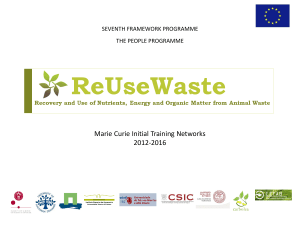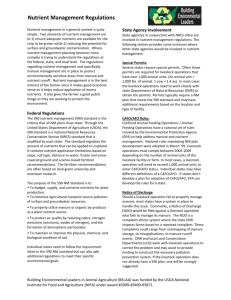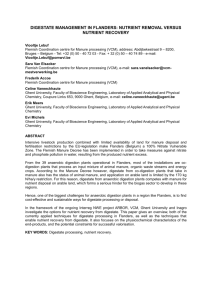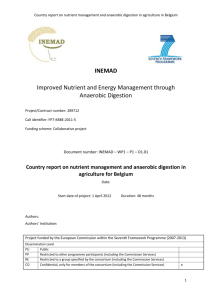full text
advertisement
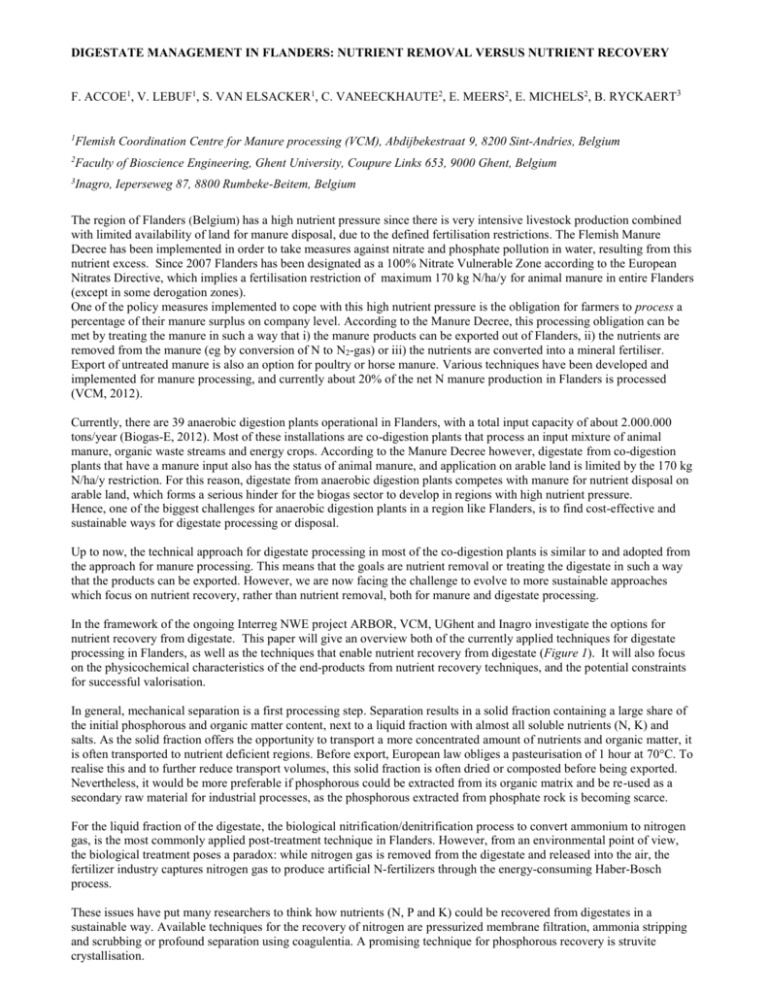
DIGESTATE MANAGEMENT IN FLANDERS: NUTRIENT REMOVAL VERSUS NUTRIENT RECOVERY F. ACCOE1, V. LEBUF1, S. VAN ELSACKER1, C. VANEECKHAUTE2, E. MEERS2, E. MICHELS2, B. RYCKAERT3 1 Flemish Coordination Centre for Manure processing (VCM), Abdijbekestraat 9, 8200 Sint-Andries, Belgium 2 Faculty of Bioscience Engineering, Ghent University, Coupure Links 653, 9000 Ghent, Belgium 3 Inagro, Ieperseweg 87, 8800 Rumbeke-Beitem, Belgium The region of Flanders (Belgium) has a high nutrient pressure since there is very intensive livestock production combined with limited availability of land for manure disposal, due to the defined fertilisation restrictions. The Flemish Manure Decree has been implemented in order to take measures against nitrate and phosphate pollution in water, resulting from this nutrient excess. Since 2007 Flanders has been designated as a 100% Nitrate Vulnerable Zone according to the European Nitrates Directive, which implies a fertilisation restriction of maximum 170 kg N/ha/y for animal manure in entire Flanders (except in some derogation zones). One of the policy measures implemented to cope with this high nutrient pressure is the obligation for farmers to process a percentage of their manure surplus on company level. According to the Manure Decree, this processing obligation can be met by treating the manure in such a way that i) the manure products can be exported out of Flanders, ii) the nutrients are removed from the manure (eg by conversion of N to N2-gas) or iii) the nutrients are converted into a mineral fertiliser. Export of untreated manure is also an option for poultry or horse manure. Various techniques have been developed and implemented for manure processing, and currently about 20% of the net N manure production in Flanders is processed (VCM, 2012). Currently, there are 39 anaerobic digestion plants operational in Flanders, with a total input capacity of about 2.000.000 tons/year (Biogas-E, 2012). Most of these installations are co-digestion plants that process an input mixture of animal manure, organic waste streams and energy crops. According to the Manure Decree however, digestate from co-digestion plants that have a manure input also has the status of animal manure, and application on arable land is limited by the 170 kg N/ha/y restriction. For this reason, digestate from anaerobic digestion plants competes with manure for nutrient disposal on arable land, which forms a serious hinder for the biogas sector to develop in regions with high nutrient pressure. Hence, one of the biggest challenges for anaerobic digestion plants in a region like Flanders, is to find cost-effective and sustainable ways for digestate processing or disposal. Up to now, the technical approach for digestate processing in most of the co-digestion plants is similar to and adopted from the approach for manure processing. This means that the goals are nutrient removal or treating the digestate in such a way that the products can be exported. However, we are now facing the challenge to evolve to more sustainable approaches which focus on nutrient recovery, rather than nutrient removal, both for manure and digestate processing. In the framework of the ongoing Interreg NWE project ARBOR, VCM, UGhent and Inagro investigate the options for nutrient recovery from digestate. This paper will give an overview both of the currently applied techniques for digestate processing in Flanders, as well as the techniques that enable nutrient recovery from digestate (Figure 1). It will also focus on the physicochemical characteristics of the end-products from nutrient recovery techniques, and the potential constraints for successful valorisation. In general, mechanical separation is a first processing step. Separation results in a solid fraction containing a large share of the initial phosphorous and organic matter content, next to a liquid fraction with almost all soluble nutrients (N, K) and salts. As the solid fraction offers the opportunity to transport a more concentrated amount of nutrients and organic matter, it is often transported to nutrient deficient regions. Before export, European law obliges a pasteurisation of 1 hour at 70°C. To realise this and to further reduce transport volumes, this solid fraction is often dried or composted before being exported. Nevertheless, it would be more preferable if phosphorous could be extracted from its organic matrix and be re-used as a secondary raw material for industrial processes, as the phosphorous extracted from phosphate rock is becoming scarce. For the liquid fraction of the digestate, the biological nitrification/denitrification process to convert ammonium to nitrogen gas, is the most commonly applied post-treatment technique in Flanders. However, from an environmental point of view, the biological treatment poses a paradox: while nitrogen gas is removed from the digestate and released into the air, the fertilizer industry captures nitrogen gas to produce artificial N-fertilizers through the energy-consuming Haber-Bosch process. These issues have put many researchers to think how nutrients (N, P and K) could be recovered from digestates in a sustainable way. Available techniques for the recovery of nitrogen are pressurized membrane filtration, ammonia stripping and scrubbing or profound separation using coagulentia. A promising technique for phosphorous recovery is struvite crystallisation. Some techniques are yet commercially available but not successful because the marketing of the end-products poses difficulties. A lot of techniques are also still under development. By reviewing the technical knowledge of the different available nutrient recovery techniques and techniques under development, as well as the characteristics of the resulting endproducts, this paper can provide appropriate marketing strategies for nutrient recycling from digestates in different regions dealing with nutrient excess problems. Figure 1: Schematic overview of digestate processing techniques (grey boxes indicate nutrient recovery techniques) References Progress report 2012- Anaerobic digestion in Flanders (2012), Biogas-E vzw, Kortrijk, Belgium VCM enquiry: Manure processing capacity in Flanders in 2011 (2012), VCM, Bruges, Belgium


